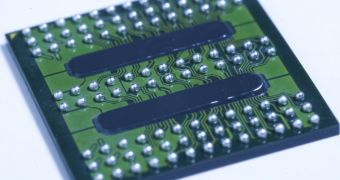The DRAM market may not be doing so well as far as consumer demand goes, but this hasn't stopped Invensas from coming up with a new memory device packaging technology.
Memory modules are all composed of multiple chips, strapped onto a PCB (printed circuit board) meant mainly to act as a mediator between them and the motherboard.
In the end, it is the chips themselves that determined the capacity, performance and price, not to mention environment footprint.
For some reason or onother, DRAM products have been selling poorly for well over a year, almost two.
Invenas has now stepped forward with a new packaging technology, not long after new module types were revealed by the latest DDR3 specification.
The technology is called xFD and is a new type of multi-die, wirebond-based method which mounts ICs (integrated circuits) upside down and “staggers them in a shingle-like configuration, incorporating short wirebonds in a structure similar to that of a window-BGA package.”
This grants a heat transfer advantage of 20 to 30 percent compared to dual-die packages (DDP) and boosts electrical performance by 50 to 70 percent in speed-bin yield (top and bottom have symmetric performance).
Finally, overall component size is reduced by 25 to 35 percent (vertically), which means that it is easier to strike higher capacities on any single module.
“We developed the xFD technology platform in response to continued industry demand for denser, faster and cheaper DRAM solutions for servers and mobile devices,” said Simon McElrea, president of Invensas Corporation.
“xFD provides single-die package performance in a multi-die configuration as well as delivering significant thickness and thermal advantages. Unlike more complex alternatives, xFD is manufactured using existing industry manufacturing capacity, significantly reducing the cost, time and risk of high-volume adoption.”
Now word yet on how long it might take for actual products to get released. A demo, at least, will take place at IDF (Intel Developer Forum).

 14 DAY TRIAL //
14 DAY TRIAL //